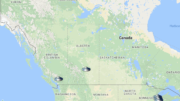Strange flying-saucer-shaped moons embedded in Saturn’s rings have baffled scientists studying images transmitted by the Cassini Spacecraft. Past research suggests that the oddly shaped moons, Pan and Atlas, are born largely from clumps of icy particles in the rings themselves, a discovery that could shed light on how Earth and other planets formed from the disk of matter that once surrounded our newborn sun. This raw, unprocessed image of Saturn’s moon, Atlas, above was taken on April 12, 2017, by NASA’s Cassini spacecraft. The flyby had a close-approach distance of about 7,000 miles (11,000 kilometers).
Observations by NASA’s Cassini spacecraft revealed the moons Atlas and Pan, each roughly 12 miles (20 kilometers) from pole to pole, have massive ridges bulging from their equators some 3.7 to 6.5 miles (6 to 10.5 kilometers) high, giving them the classic UFO appearance.
At first glance, one could assume that fast rates of spin might have stretched Atlas and Pan (below) out into such unusual shapes, just as tossing a disk of pizza dough flattens it out. But astronomers discovered that each takes about 14 hours to complete a rotation -not nearly fast enough to cause the flattened, disk-like shape.
Carolyn Porco, a planetary scientist and imaging team leader for the Cassini mission, and her colleagues suspected these peculiar moons could be formed mostly from Saturn’s rings, rather than just from fragments produced in collisions of larger moons. The location of the ridges lined up precisely with the rings of icy particles in which they were embedded.
After analyzing the shapes and densities of the moons from data captured by Cassini, Porco’s team found Pan and Atlas appear to be mostly light, porous, icy bodies, just like the particles making up the rings. Computer simulations suggest one-half to two-thirds of these bizarre moons are made of ring material, piled up on massive, dense fragments of bigger moons that disintegrated billions of years ago after catastrophic collisions with one another.
Astrophysicist Sebastien Charnoz at University of Paris Diderot, suggested that the Saturnian ice-clump moons elongated and bulged out into the flying-saucer shapes in the manner of accretion disks, which “are found everywhere in the universe—around black holes, around stars, around Jupiter.”
Charnoz added that understanding how the icy particles piled up to make these shapes could shed light on how matter in the protoplanetary disks of our Solar System that formed around our newborn sun could have clumped together to make planets.
The Daily Galaxy via NASA/JPL, New Scientist, and Space.com
The Daily Galaxy via NASA/JPL


Be the first to comment on "Saturn’s Bizarre ‘UFO Moons’ –“Fragments of Large Moons that Disintegrated Billions of Years Ago”"